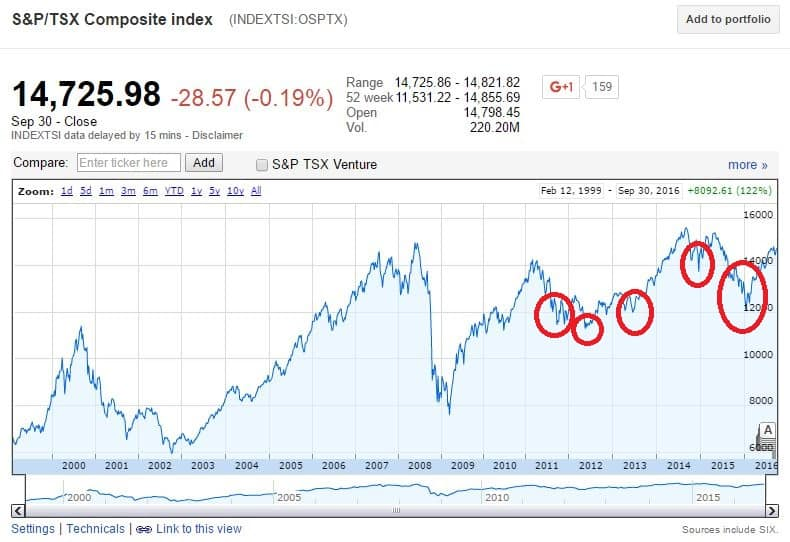We are in the midst of one of the longest bull markets in history. I can’t predict how the stock markets will behave in the future but there is one thing I can predict with 100% accuracy- the bull market will not last forever. Eventually good times will end and the nasty bear will appear. Stock markets will fall and people will freak out.
My personal experience with the nasty bear market
I was in high school during the dot com bubble so I don’t have much recollection about this particular crash. The only bear market I have experienced as an investor was the financial crisis in 2008/2009. Back then I saw my company cutting 10% of work force overnight and then another 15% a few months later. I had a few managerial changes as my manager and people above him were let go during this time. As a new grad that had just entered the work force, I had no idea if my job was safe or not. I updated my resume and looked for possible job opportunities almost every month just to keep my options open.
Before the financial crisis, I had just started investing in individual stocks. Like many people, I felt uneasy holding on stocks during uncertain times. My investment portfolio value took a major hit, went down by more 50% at one point. However, because I didn’t have any short term needs for money, I thought I would hold onto these individual stocks and invest in more stocks when opportunity presented itself.
An example of this was when I purchased 100 shares of Royal Bank at $26.92 on Feb 26, 2009. I thought I had purchased at an all time low and patted myself on the back.
The stock recovered a bit in early March but then the markets started dropping again. I panicked and decided to liquidate all my shares at $29.05. I thought I was a genius for making over $300 in less than a month.
Little did I know, the drop was just momentary. Royal Bank stock price would continue to climb after my sell.
Today the stock worth around $81. In addition to the 3x price appreciation, I would have received about $2,000 in dividends. My yield on cost would be over 10%.
A missed opportunity? Perhaps.
Instead of being resentful, I decided to use this experience as a value lesson.
What did I learn from the financial crisis?
I learned taking advantage of any market down turns if crucial if I’m investing for the long run. This is exactly what I have been doing since the financial crisis, whenever there was a market correction (i.e. 5% or 10% drop). I would buy more stocks that I deemed were on discount, whether the stock paid dividends or not. This required having some cash on the sideline.
Essentially I was deploying the buy and hold strategy. Continue to hold whatever stocks we had and add more stocks to our investment portfolio.
But is buy and hold strategy the right strategy? Or is it better to go with time the market and capital appreciation?
I think that decision comes down to what investing strategy you are comfortable with. It also comes down to your risk tolerance.
When I first started investing, dividend growth investing wasn’t my focus. I was looking for making quick bucks when it comes to stock investing. I was not afraid to trade leveraged ETFs like HNU, HND, UWM, TQQQ, SQQQ, and etc. I also took some investing courses and learned to use trading techniques and indicators to determine when to buy and sell. The basic concept was to buy based on stock momentum and sell when the momentum was gone. Essentially buy high, sell higher. Furthermore, all the trades were done with 1% risk each. To be more specific, every trade I executed was only 1% of my portfolio value.
How did this work? For example, if my portfolio value is $100,000, the first trade I would buy $1,000 worth of a particular stock. If the portfolio value increases to $150,000 with 1 open position, I would buy $1,500 worth of a particular stock for my next trade. Now if the portfolio value dropped down to $95,000, the next trade would only be $950.
Did these techniques and risk management made me some quick money?
Yes and no.
The 1% risk management was an excellent practice in theory and the trade techniques worked well. What was the catch? Well, because I had a small portfolio, my 1% trades were very small in value. I was only able to trade 10 or 20 shares each time. Even if the stock price went up by $10 or more, the absolute capital appreciation wasn’t big due to the small number of shares I owned.
What kind of stocks was I trading?
Alexion Pharmaceuticals (ALXN) ~$120 today
I traded ALXN when it was around $30.
Priceline (PLCN) ~$1,470 today
I traded PLCN when it was around $400.
Ulta Salon, Cosmetics & Fragrance (ULTA) ~$240 today
Started trading ULTA when it was around $80.
Questcor Pharmaceuticals (QCOR)
Started trading around $40. Questcor was acquired in 2014. Stock was around $90 in 2014.
Qihoo 360 Technology (QIHU) ~$76 today but was trading ~$100 in 2014
Started traded QIHU in 2012 around $24.
Yes I did made a few bucks but I could have made more if I simply held onto these stocks and sold them later.
Could of.
Should of.
The two lamest excuses when it comes to investing.
Don’t get me started on my missed opportunity of Google, Apple, and Facebook. 🙂
Pending market crash? What to do?
Currently, we have quite a few hundred thousand dollars invested in the stock market. Part of the portfolio, the dividend portfolio, yields about $1,000 of dividend income per month.
If we take a look at the stock markets, it’s easy to predict that a pending correction is coming.
What fueled the current second longest bull market in history? I believe the bull was fueled mostly by multiple QEs, super low interest rates, and governments continue pumping money into the markets.
Is the bull market going to end? Is a correction coming soon?
Yes I think a correction is coming soon.
But when? And how big is this correction?
10%?
20%?
50%?
80%?
I have no idea. There have been a few times in the past 5 years I though the bull market was going to end and a major correction was on the horizon….
But instead of markets tumbling down, the bull simply rested for a short period and the run continued.
The drops were short lived.
Would we continue to see such trends? Or would we finally see a major bear market?
I can’t predict the future, hence I do not know that answer.
In the last while, I have noticed a number of bloggers liquidating their portfolio and started holding more cash or investing in precious metal sector. A few examples:
- Jay at FI Fighter liquidated his dividend portfolio late last year and start investing in precious metals.
- Sabeel at Roadmap2Retire recently sold about 1/3 of his dividend portfolio and started to invest in some precious metals.
- Tyler at Dividend Hustler had a reset and sold off all $600k (!!!) of dividend stocks
Now there’s nothing wrong with changing your investing strategy. In fact, I applaud all three bloggers for not following the herd. In Jay’s case, he was buying gold and silver stocks when the sector was near the bottom but not quite a the bottom. In January his precious metals portfolio was down around 14% (~$36k). He stuck to his guns and continued adding more precious metals stocks. Why? Because he believe in his investing thesis. Quickly the gold & silver markets turned and now Jay is up by over 100% (~$404k). This kind of performance is life changing. Although people may think Jay took on quite a bit of risk with his precious metals play, I disagree. Jay is not completely all in with his money on precious metals as he owns real estates in the Bay area.
When it comes down to it, it’s all about how you manage and mitigate your investment risks. Do you own real estate? Do you own other assets? Do you own non-dividend stocks? Do you own bonds? Do you own GIC’s? How much cash reserve do you hold? All these need to be considered when you decide to switch your investment strategy.
Given that we have a large sum of money already invested in the stock market, what will we do on this impending correction?
- Do nothing, continue buying stocks periodically as what we have been doing
- Liquidate all of our holdings and start holding cash
- Liquidate some holdings and start buying other assets like gold and silver
- Start holding on a larger reserve of cash and wait for an opportunity
As mentioned, I did a combination of option #1 and #4 in the past number of years – simply continue buying stocks whenever they went on sale. But now I’m at a bit of a crossroad. I’m not as gutsy as Tyler so #2 is a no go for me (plus unlike Tyler, we have no intention to buy another property). Should I continue with option #1? Or should we start doing option #3? Or should we start doing option #4? Or a combination of them?
I don’t know what the correct answer is. Perhaps we will hold a larger cash reserve and be more patient (option #4). Since we also own some non-dividend paying stocks, perhaps we can start buying more of these stocks that are undervalued. Or perhaps we can start doing more research and start investing in precious metals like gold and silver.
It’s important to always considering stock valuation and fundamentals. If a stock’s PE is at 50 and the historical average is 13, it’s probably not the best time to buy this stock. It doesn’t matter if everyone you know if buying this stock. When the valuation is this poor, you should stay away. If you ignore stock fundamentals, you will most likely get burned down the road.
Don’t be scared to not follow the herd. Think for yourself. Question authorities.
For Mrs. T and I, our goal is to reach financial independence sometime in the next 10 years (or less). Right now the plan is to be financial independent when our dividend income is greater than our expenses. But it doesn’t mean we can’t shift our focus to the capital appreciation portfolio that we haven’t paid as much attention to lately.
Which option(s) will we use? Stay tuned. 🙂





